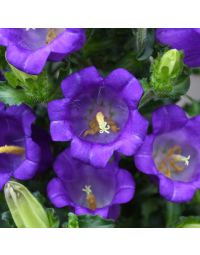Fall is a good time to divide spring and summer blooming perennials. Note: divide fall blooming perennials in spring. The process is pretty straightforward with the exception of Iris which need more attention. Read more on Iris below.
We divide perennials for several reasons:
- Reduced flower production
- Smaller flower heads
- The center of the plant had died out
- Plant starts to flop and needs staking
- It’s outgrown its boundaries
The goals for dividing include:
- Rejuvenating the plant to increase performance
- Control the size
- Increase the number of plants
General division techniques:
- Water the area well 1 to 2 days before dividing.
- Cut the foliage back to about 6 inches or half the plant.
- Use a spade to dig around the plant.
- A garden fork works well to lift the plant out of the soil without injuring the roots.
- Knock the soil off the roots and inspect them. Cut out any yellow or mushy parts.
- Use the spade or a garden knife to make your divisions.
Plants to divide in late summer to fall:
- Beebalm
- Campanula
- Cranesbill (Geranium – perennial)
- Black Eyed Susan
- Garden Phlox
- Hosta
- Daylilies
- Iris
- Peony
- Poppy
- Yarrow
- Coreopsis
- Coneflower
- Yucca
Dividing Daylilies:
These plants often need dividing every three years. Fall is the perfect time to thin and transplant crowded clumps. It’s easy too! Separate and cut foliage back by 50%. Replant or share your extras!

Daylilies – remember to water well before dividing any of your plants
Dividing Hosta:
You can divide Hosta nearly anytime but it’s best not to do it while flowering. These are one of the easiest plants to divide.
In fall:
- After flowers have faded and the foliage is fading, dig up your hosta and wash away the soil from the roots.
- Cut back the foliage with pruners.
- Use a sharp knife or a spade and divide!

- Find the perfect spot in shade to part shade and replant or give them away!
Note: If dividing in spring, you’ll see lavender eyes – the new spring growth. Take a sharp knife and cut to one side of those eyes. Replant. You can’t hardly kill these plants!

Planting & Transplanting Iris:
The Greek goddess Iris walked a rainbow pathway through the sky and the flower named for her has a rainbow of flower color. This radiant flower was regarded as the symbol of light and is emblematic of promise, light and hope, pride and bravery.
The best time to plant and transplant Rhizomatous Iris is late July through September. Rhizomes are horizontally growing underground stems that are used as food storage for the plants. Rhizomatous Irises include the common bearded Iris as well as the beardless Siberian and Japanese Iris.
Most Iris need to be divided every three to five years. If your plants are not producing many flowers, it’s time to DIVIDE and CONQUER!
Steps for dividing iris:
- Cut back the foliage to about one-third its height.
- Lift the entire clump with a spade.
- Use a sharp knife to separate the rhizomes. Dip the knife in a ten percent bleach water mixture after each cut.
- While dividing, make sure to inspect the rhizomes for soft rot and iris borer. Iris borer is the worst insect problem that can affect Iris. An Iris borer adult is a brownish moth and she lays her eggs in fall on iris leaves, which over winter there and hatch into caterpillars during April and May. The caterpillars first bore into the Iris leaves and by the end of July, the caterpillars move into the rhizome to eat and mature. In early August, the caterpillars move from the soil to pupate into a moth. Learn more Iris Borer UofMN Ext.

Iris Borer UofMN Ext.
- When dividing, the Iris borer will be a mature pink caterpillar inside the rhizome and it will be mushy to the touch. Bacterial soft rot often accompanies iris borer damage. If there is evidence of Iris borer, spray with a fungicide the following spring.
- To avoid any decay on the new breaks or cuts, dust the rhizomes with a powdered fungicide such as sulfur or Bulb Dust.
- The new transplants should have a firm rhizome with roots and a fan of leaves.
- Remove and discard the old rhizomes and replant the younger smaller rhizomes that grow off the older stems.

- Replant in a sunny, well-drained garden spot. Dig the hole about 5 inches deep and build a small mound in the middle to place the rhizome.
- Place the rhizome on the mound allowing the roots to fall down either side and cover the roots so that the rhizome is ever so slightly exposed. Do not plant rhizomes too deep or it may rot or not flower.

- As a rule of thumb, Iris are planted 18-24” apart in groups of three to seven sections of one variety.
- Typically, the rhizomes are planted so the leaf fans face in one direction.
- Fall sanitation is very important in the control of Iris borer. After the first hard frost, remove and destroy the old iris foliage and plant debris to remove any eggs.
- Keep well-watered, but not too wet.
- Cover after the ground has frozen if you are dividing.
The experts at Gertens are always available to answer your questions!





